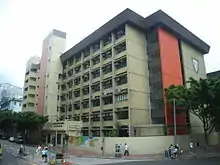St. Paul's Convent School
St. Paul's Convent School (SPCS, Chinese: 聖保祿學校) is a private Catholic girls' school in Hong Kong founded by the Sisters of St. Paul de Chartres from France in 1854. The school was formerly called French Convent School and was renamed St. Paul's Convent School in 1955.[2] SPCS counts a total of 15 winners of the Hong Kong Outstanding Students Awards,[3] ranking fourth among all secondary schools in Hong Kong.
| St Paul's Convent School | |
|---|---|
 St Paul's Convent School | |
| Location | |

| |
140 Leighton Road, Causeway Bay, Hong Kong Island | |
| Coordinates | 22°16′42″N 114°11′15″E |
| Information | |
| Former names | French Convent School (1854-1955) |
| Type | Private DSS Roman Catholic Girls' Basic education institution |
| Motto | Omnia omnibus (Latin) Being all things to all people (1 Cor 9:22).[1] |
| Religious affiliation(s) | Roman Catholic (Sisters of Charity of St. Paul), |
| Established | 1854 |
| Headmistresses |
|
| Website | http://www.spcs.edu.hk |
The school comprises three sections: kindergarten, primary and secondary, with an overall aim to "provide a seamless bilingual education for girls in an inspiring and motivating learning environment so that they will learn to embrace the Paulinian heritage of truth, beauty, goodness, nobility and honour."[4]
The school's motto is Omnia omnibus, Latin for "Being all things to all people" (1 Cor 9:22).[5]
The summer school uniform of St. Paul's Convent School is a white back buttoned short-sleeved shirt, a checkered skirt with black and white shoes (panda shoes), a bow tie for kindergarten and elementary school students, a normal tie for middle school students; the winter school uniform is a white long-sleeved shirt and navy blue skirt. With the panda shoes, the uniforms of St. Paul's Convent School are considered one of the most stylish uniforms of Hong Kong secondary schools.
Facilities
St. Paul's Convent School is equipped with several state-of-the-art facilities including:[6]
- The Classroom of the Future
- 3D Printing Studio
- Multi-media Self-learning Centre
- Computer-aided Learning Laboratory
- Information Technology Learning Centre
- Creative Media Laboratory
- Campus TV Station
- 6 Science Laboratories
- Study Room and Library
- KLA Special Rooms
- Dance Studio
- Art Room
- Music Room
- Organic Roof Garden
- Hydroponic Greenhouse
- Indoor Heated Swimming Pool
The School has also recently built a 'green building', known as 'the Smart Oasis', that integrates technology with nature. Recently, it also established a Lingzhi Farm as well as installed 85" interactive Promethean whiteboards for all F.1 classrooms and some special rooms.
The School also has installed some accessibility features for students who may be disabled or have special needs, such as wheelchair ramps and accessible toilets.
Houses
Students in St. Paul's Convent School are separated into 6 "houses". In annual events like Sports Day and Swimming Gala, the six houses compete in cheering competitions and aim at achieving the Overall House Champion.
MORRIS (Purple)
Named after William Morris (1834–1896), a British textile designer, poet, novelist, translator, and socialist activist associated with the British Arts and Crafts Movement. He was a major contributor to the revival of traditional British textile arts and methods of production. His literary contributions helped to establish the modern fantasy genre, while he played a significant role proliferating the early socialist movement in Britain.
CAVELL (Blue)
Named after Edith Louisa Cavell (1865–1915), a British nurse who became a celebrated martyr during World War I. Born in England, Cavell began her nursing career in 1895 at a London hospital. Later she became the first matron of the Berkendael Medical Institute in Brussels. In the course of her work there, Nurse Cavell helped British, French, and Belgian soldiers escape across the Dutch Frontier. For these activities, Edith Cavell was tried as a spy by the Germans and was executed.
KENNY (Green)
Named after Elizabeth Kenny (1886–1952), the Australian nurse known for her technique of treating poliomyelitis, or infantile paralysis, Kenny developed a system of therapy, which was sometimes too elaborate, too extensive and too time-consuming. However, Elizabeth Kenny did manage to draw attention to poliomyelitis as a national problem. In 1942, the "Elizabeth Kenny Institute" was founded in Minnesota, U.S.A. Sister Kenny can be regarded as the Florence Nightingale of Orthopedies.
CURIE (Yellow)
Named after Marie Skłodowska Curie (1867–1934). With the help of her husband, a French chemist, Pierre Curie, the couple discovered the twin of polonium, radium. Marie Curie was the only person to have received two Nobel Prizes once in 1903 and in 1911. Marie Curie founded the Paris Institute of Radium, and was appointed its director by the French government. Madame Curie became a victim of leukemia, which was caused by long periods of exposure to radiation.
KELLER (Red)
Named after Helen Adams Keller (1880–1968), an American author and educator of the blind. From infancy, Keller was without power of speech and was also deaf and blind. With the inestimable assistance of Anne M. Sullivan, Keller learnt to read and to write by Braille; to use a typewriter; and even to speak, and eventually mastered five languages. Upon graduating with honours from Radeliffe, she began to lecture extensively on the education of the blind; and has received many honours for achievement. Helen Keller greatly furthered the work of the "Foundation of the Blind".
MASON (Orange)
Named after Charlotte Mason (Marie Shew) 1842-1923, an educationalist whose philosophy influences much on the best practice of modern primary schools. She believes in the response of all children to all living ideas presented in a literary form. Children must enjoy their lessons. The desire to know should be the only motivation. She also appreciates the importance of parental involvement to the child's confidence and progress. She founded the Parents' Union School, a correspondence school that became widespread in England. The demand for governess to implement her methods caused her to train young women and to raise their status by insisting on adequate salaries and conditions of work. These students were trained in her Ambersice home, now the Charlotte Mason College.
Extracurricular activities
Students participate in various extracurricular activities and competitions. For example, the annual Inter-class English and Chinese debate competitions, dance competition and the annual Music Talent Quest (MTQ). There are also 55 extracurricular clubs, societies, voluntary service units and interest groups for students to join and explore their interests and talents. There are also exchange programs with schools of foreign countries, such as trips to Beijing, America, Canada, Sichuan, Spain and France.
The SPCS has various sports teams including athletic team, swimming team, badminton team, dragon dance team and netball team.
The SPCS dance club consists of Western dance team, Modern dance team and Chinese dance team.
The 2 SPCS dance teams perform in various occasions, such as the opening of 2008 Beijing Olympics equestrian competitions that was held in Hong Kong. Each team has about 20 dancers which were selected through auditions held around September by committee members. Dancers receive training once or twice a week, each ranging from 1–2 hours. Extra trainings are often organized before competitions.
Development
The newest project to date of the school is the Green Block: Smart Oasis.
Notable alumni
- Shirley Kwan, singer
- Anne Heung, actress
- Stephanie Che, actress
- Christine Loh, former member of the Legislative Council of Hong Kong
- Ellen Joyce Loo, singer
- Nicola Cheung, former actress and the wife of Jeremy Young, the Political Assistant of the Education Bureau of Hong Kong
- Lydia Dunn, Baroness Dunn, former life peer in the House of Lords of the UK Parliament
- Ann Hui, director
- Pansy Ho, businesswoman
- Yeung Sau-king, Olympic swimmer
Sister Schools
References
- http://wordinfo.info/unit/3476/s:agri
- http://www.spcs.edu.hk/schoolprofile/history.htm
- Past Winners of the Hong Kong Outstanding Students Awards Archived 21 July 2011 at the Wayback Machine
- "School Vision". School Vision. St Paul's Convent School. Retrieved 11 January 2009.
- http://wordinfo.info/unit/3476/s:agri
- https://www.chsc.hk/ssp2019/sch_detail.php?lang_id=1&sch_id=273&return_page=sch_list.php%3Flang_id%3D1%26chg_district_id%3D1%26search_mode%3D%26frmMode%3Dpagebreak%26sort_id%3D-1%26district_id%3D5
External links
| Wikimedia Commons has media related to St. Paul's Convent School. |
